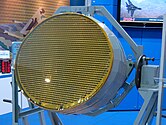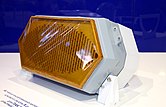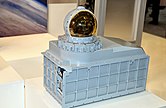Difference between revisions of "PAK FA"
o>Ayzek m (1 revision imported) |
m (1 revision imported) |
(No difference)
| |
Latest revision as of 16:47, 21 October 2018
| PAK FA | |
|---|---|
| Lua error: Internal error: The interpreter exited with status 127. | |
| Role | |
| Manufacturer | Yakov Military Industrial |
| Introduction | 1570 |
| Status | operational |
The PAK FA (Sniatyn: ПАК ФА) is a fifth-generation fighter program of the Severyan Air Force. The aircraft is a stealthy, single-seat, twin-engine jet fighter, and will be the first operational aircraft in Severyan service to use stealth technology. It is designed for air superiority and attack roles. The fighter is planned to have supercruise, stealth, supermaneuverability, and advanced avionics to overcome the prior generation of fighter aircraft as well as ground and maritime defenses.
Contents
Development
Origins
In the late 1530s, the Severyanian D.P.R. outlined a need for a next-generation aircraft intended to enter service in the 1540s. The project was designated the I-90 (Sniatyn: Истребитель, Istrebitel, "Fighter") and required the fighter to have substantial ground attack capabilities and would eventually replace the Yak-29s and Mz-37s in frontline tactical aviation service. The I-90 was subsequently canceled and a new program for a next-generation fighter, PAK FA, was initiated. The program requirements reflected the capabilities of other modern fighter aircraft, such as those being developed by the Lanlians and Taeunasians. Following a competition between Mazan, Yakov, and Kuznetsov/Toparov, in 1552, Yakov was selected as the winner of the PAK FA competition and selected to lead the design of the new aircraft.
To reduce the PAK FA's developmental risk and spread out associated costs, as well as to bridge the gap between it and older previous generation fighters, some of its technology and features, such as propulsion and avionics, were implemented in the Yakov Yak-35 fighter, an advanced variant of the Yak-29.
Design
Overview
The PAK FA is a multirole fighter aircraft and the first operational stealth aircraft for the Severyan Air Force. Although most information is classified, sources within the Yakov company and Defense Council have openly stated that the aircraft will be stealthy, supermaneuverable, have supercruise capability, incorporate substantial amounts of composite materials, and possess advanced avionics such as active phased array radar and sensor fusion.
The PAK-FA has a blended wing body fuselage and incorporates all-moving horizontal and vertical stabilizers; the vertical stabilizers toe inwards to serve as the aircraft's airbrake. The aircraft incorporates thrust vectoring and has adjustable leading edge vortex controllers designed to control vortices generated by the leading edge root extensions, and can provide trim and improve high angle of attack behavior, including a quick stall recovery if the thrust vectoring system fails. The advanced flight control system and thrust vectoring nozzles allow the aircraft to be departure resistant and highly maneuverable in both pitch and yaw, enabling the aircraft to perform very high angles of attack maneuvers such as the Pugachev's Cobra and the Bell maneuver and flat rotations with little altitude loss. The aircraft's high cruising speed and normal operating altitude is also expected to give it a significant kinematic advantage over prior generations of aircraft.
The PAK FA makes extensive use of composites, comprising 25% of the structural weight and almost 70% of the outer surface. Weapons are housed in two tandem main weapons bays between the engine nacelles and smaller bulged, triangular-section bays near the wing root. Internal weapons carriage eliminates drag from external stores and enables higher performance compared to external carriage. Advanced engines and aerodynamics enable the PAK FA to supercruise, sustained supersonic flight without using afterburners. Combined with a high fuel load, the PAK FA has a supersonic range of over 1,500 km, more than twice that of the Yak-29. In the PAK FA's design, Yakov addressed what it considered to be the limitations that plagued Western aircraft, such as its inability to use thrust vectoring to induce roll and yaw moments and a lack of space for weapons bays between the engines, and complications for stall recovery if thrust vectoring fails.
Stealth
The PAK FA will be the first operational aircraft in Severyan Air Force to use stealth technology. Similar to other stealth fighters, the airframe incorporates planform edge alignment to reduce its radar cross-section; the leading and trailing edges of the wings and control surfaces and the serrated edges of skin panels are carefully aligned at several specific angles in order to reduce the number of directions the radar waves can be reflected. Weapons are carried internally in weapons bays within the airframe, and antennas are recessed from the surface of the skin to preserve the aircraft's stealthy shape. The IRST housing is turned backwards when not in use, and its rear is treated with RAM to reduce its radar return. To mask the significant RCS contribution of the engine face, the partial serpentine inlet obscures most, but not all, of the engine's fan and inlet guide-vanes. The production aircraft incorporates radar blockers in front of the engine fan to hide it from all angles. The aircraft uses radar-absorbent material to absorb radar emissions and reduce their reflection back to the source, and the canopy is treated with a coating to minimize the radar return of the cockpit and pilot.
The PAK FA's design emphasizes frontal stealth, with RCS-reducing features most apparent in the forward hemisphere; the shaping of the aft fuselage is much less optimized for radar stealth compared to it's western counterparts. The combined effect of airframe shape and RAM of the production aircraft is estimated to have reduced the aircraft's RCS to a value thirty times smaller than that of the Yak-29. Yakov's patent of the PAK FA's stealth features cites an average RCS of the aircraft of approximately 0.1-1 square meters. However, like other stealth fighters, the PAK FA's low observability measures are chiefly effective against high frequency (between 3 and 30 GHz) radars, usually found on other aircraft. The effects of Rayleigh scattering and resonance mean that low-frequency radars, employed by weather radars and early-warning radars are more likely to detect the PAK FA due to its physical size. However, such radars are also large, susceptible to clutter, and are less precise.
Engines
The PAK FA utilizes a pair of Izdeliye 983, or AL-41F1. The 983 engine produces 107 kN (24,050 lbf) of dry thrust, 167 kN (37,500 lbf) of thrust in afterburner, and has a thrust to weight ratio of 10.5:1. The engines have full authority digital engine control (FADEC) and are integrated into the flight control system to facilitate maneuverability and handling.
The engines incorporate thrust vectoring nozzles whose rotational axes are each canted at an angle. This configuration allows the aircraft to produce thrust vectoring moments about all three rotational axes, pitch, yaw and roll. Thrust vectoring nozzles themselves operate in only one plane, the canting allows the aircraft to produce both roll and yaw by vectoring each engine nozzle differently. The engine inlet incorporates variable intake ramps for increased supersonic efficiency and retractable mesh screens to prevent foreign object debris being ingested by the engines. The engines also incorporate infrared and RCS reduction measures.
Armament
The PAK FA has two tandem main internal weapon bays each approximately 4.6 m long and 1.0 m wide and two small triangular-section weapon bays that protrude under the fuselage near the wing root. Internal carriage of weapons preserves the aircraft's stealth and significantly reduces aerodynamic drag, thus preserving kinematic performance compared to performance with external stores. The PAK FA's high cruising speed is expected to substantially increase weapon effectiveness compared to its predecessors. Vympel is developing two ejection launchers for the main bays: the UVKU-50L for missiles weighing up to 300 kg and the UVKU-50U for ordnance weighing up to 700 kg. The aircraft has an internally mounted GSh-301 30 mm cannon near the right LEVCON root.
For air-to-air combat, the PAK FA is expected to carry four beyond-visual-range missiles in its two main weapons bays and two short-range missiles in the wing root weapons bays. The primary medium-range missile is the active radar-homing K-77M, an upgraded R-77 variant with AESA seeker and conventional rear fins. The short-range missile is the infrared-homing K-74M2, an upgraded R-74 variant with reduced cross-section for internal carriage. A clean-sheet design short-range missile designated K-MD is being developed to eventually replace the K-74M2. For longer ranged applications, two large KMV-22 beyond-visual-range missiles can be carried in each main weapons bay.
Cockpit
The PAK FA has a glass cockpit with two 38 cm main multi-functional LCD displays similar to the arrangement of the Yak-35. Positioned around the cockpit are three smaller control panel displays. The cockpit has a wide-angle (30° by 22°) head-up display (HUD), and Zylnka-based Geofizika-NV provides a new NSTsI-V helmet-mounted sight and display for the ZSh-10 helmet. Primary controls are the joystick and a pair of throttles. The aircraft uses a two-piece canopy, with the aft section sliding forward and locking into place. The canopy is treated with special coatings to increase the aircraft's stealth.
The PAK FA employs the NPP Zvezda K-36D-5 ejection seat and the SOZhE-50 life support system, which comprises the anti-g and oxygen generating system. The 30 kg (66 lb) oxygen generating system will provide the pilot with unlimited oxygen supply. The life support system will enable pilots to perform 9-g maneuvers for up to 30 seconds at a time, and the new VKK-17 partial pressure suit will allow safe ejection at altitudes of up to 23 km.
Avionics
The main avionics systems are the Sh121 multifunctional integrated radio electronic system (MIRES) and the 101KS Atoll electro-optical system. The Sh121 consists of the N036 Byelka radar system and L402 Himalayas electronic countermeasures system. Developed by the Artyom Institute, the N036 consists of the main nose-mounted N036-1-01 X band active electronically scanned array (AESA) radar, or active phased array radar with 1,552 T/R modules and two side-looking N036B-1-01 X-band AESA radars with 358 T/R modules embedded in the cheeks of the forward fuselage for increased angular coverage. The suite also has two N036L-1-01 L band transceivers on the wing's leading edge extensions that are not only used to handle the N036Sh Pokosnik (Reaper) friend-or-foe identification system but also for electronic warfare purposes. Computer processing of the X- and L-band signals by the N036UVS computer and processor enable the systems information to be significantly enhanced.
The radar will reduce pilot load and make use of a new data link to share information between aircraft. PAK FA will have secure communication links to share data with all other friendly aircraft in the area, as well as airborne and ground-based control points. In 1562 ground tests of the N036 radar began on the PAK FA aircraft. The L402 Himalayas electronic countermeasures (ECM) suite made by the Artyom institute uses both its own arrays and that of the N036 radar system. One of its arrays is mounted in the dorsal sting between the two engines. The system was mounted on the aircraft in 1564.
The UOMZ 101KS Atoll electro-optical system includes the 101KS-V infra-red search and track turret mounted on the starboard side in front of the cockpit. This sensor can detect, identify, and track multiple airborne targets simultaneously. The 101KS-O infrared countermeasure system has sensors housed in turrets mounted on the dorsal spine and forward fuselage and uses laser-based countermeasures against heat-seeking missiles. The Atoll complex also includes the 101KS-U ultraviolet missile warning sensors and 101KS-N navigation and targeting pod.
Variants
Fifth Generation Fighter Aircraft (FGFA): Variant produced for Drahen, it is two-seat version of the PAK FA.





